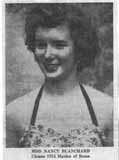Clinton Heights Lutheran Church
Friday, September 12th, 2008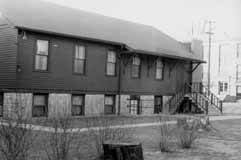 During the 1900s, the history of Clintonville churches is always a story of growth and overcrowding. Here are some pictures of the Clinton Heights Lutheran Church. The original church, a white frame mission chapel shown in my book, was build around 1922.
During the 1900s, the history of Clintonville churches is always a story of growth and overcrowding. Here are some pictures of the Clinton Heights Lutheran Church. The original church, a white frame mission chapel shown in my book, was build around 1922.
 Their Sunday School grew quickly, and by the late 1940s classes were held in adjacent houses and in the church kitchen (shown). Members voted to start a sister congregation on Morse Road (North Community Lutheran Church) to serve the burgeoning population in that area. A new church on Clinton Heights was dedicated in 1951 to serve the legacy members’ needs.
Their Sunday School grew quickly, and by the late 1940s classes were held in adjacent houses and in the church kitchen (shown). Members voted to start a sister congregation on Morse Road (North Community Lutheran Church) to serve the burgeoning population in that area. A new church on Clinton Heights was dedicated in 1951 to serve the legacy members’ needs.
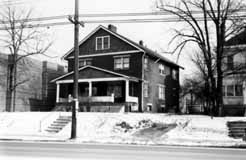 In 1971, the double house located to the south of the church was razed and the parking lot developed. In the 1990s an additional house to the east was torn down to supplement their parking. (Photos courtesy of Clinton Heights Lutheran Church)
In 1971, the double house located to the south of the church was razed and the parking lot developed. In the 1990s an additional house to the east was torn down to supplement their parking. (Photos courtesy of Clinton Heights Lutheran Church)
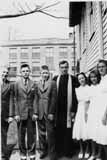 This photo shows the Catechism class on 1941, left to right: Gordon Brevoort, Fred Gardner, James Hagely, Rev. Harold Moench, Norma Montague, Helen Marshall, and Patty Allard. (Photo courtesy of Gordon Brevoort)
This photo shows the Catechism class on 1941, left to right: Gordon Brevoort, Fred Gardner, James Hagely, Rev. Harold Moench, Norma Montague, Helen Marshall, and Patty Allard. (Photo courtesy of Gordon Brevoort)

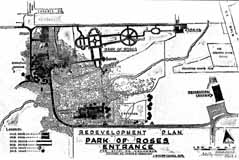
 Construction began June 1952. Minimal grading was necessary as the gentle slope of the meadow was ideal for drainage and air circulation. The entire area of 13 acres had sandy loam topsoil to a depth of 11-15 inches, which was indeed fortunate. All beds were excavated to a depth of 24 inches. The existing soil was removed and mixed with imported peat moss and commercial fertilizer. The materials were mixed four times before returning to the beds. The beds were allowed to settle before any planting was begun. (Photo courtesy of Terry Miller)
Construction began June 1952. Minimal grading was necessary as the gentle slope of the meadow was ideal for drainage and air circulation. The entire area of 13 acres had sandy loam topsoil to a depth of 11-15 inches, which was indeed fortunate. All beds were excavated to a depth of 24 inches. The existing soil was removed and mixed with imported peat moss and commercial fertilizer. The materials were mixed four times before returning to the beds. The beds were allowed to settle before any planting was begun. (Photo courtesy of Terry Miller) There were at least 3 bowling alleys in Clintonville: Olentangy Bowling Center (shown here), where Giant Eagle is today; at Graceland (northwest end), and also on the east side of High Street between Oakland Park and Dunedin. Hanging out at bowling alleys was a big deal for many teenagers—whether you bowled or not was immaterial. (Photo courtesy of Galen Gonser)
There were at least 3 bowling alleys in Clintonville: Olentangy Bowling Center (shown here), where Giant Eagle is today; at Graceland (northwest end), and also on the east side of High Street between Oakland Park and Dunedin. Hanging out at bowling alleys was a big deal for many teenagers—whether you bowled or not was immaterial. (Photo courtesy of Galen Gonser) Reading has always been a popular Clintonville activity, in part because of its great library programs. The children above are planning the activities for the 1954 National Book Week. (Photo courtesy of the Clintonville Historical Society)
Reading has always been a popular Clintonville activity, in part because of its great library programs. The children above are planning the activities for the 1954 National Book Week. (Photo courtesy of the Clintonville Historical Society)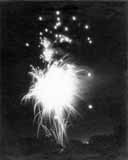 Clintonville’s Fourth of July celebration goes back at least as far as the 1930s, when The Booster and local business association sponsored an annual summer or fall community picnic at Olentangy Amusement Park. (The annual get-together may well be older yet.) Much like today, the early events had pet parades, bike parades, and fireworks. After the amusement park closed, the annual event was held at the Columbus Zoo. And then, when Whetstone Park was dedicated in the early 1950s, the community picnic was moved there and “annualized” to be held on the Fourth of July. The annual community breakfast, originally held for the volunteer workers of the Fourth of July picnic, quickly became another holiday tradition.
Clintonville’s Fourth of July celebration goes back at least as far as the 1930s, when The Booster and local business association sponsored an annual summer or fall community picnic at Olentangy Amusement Park. (The annual get-together may well be older yet.) Much like today, the early events had pet parades, bike parades, and fireworks. After the amusement park closed, the annual event was held at the Columbus Zoo. And then, when Whetstone Park was dedicated in the early 1950s, the community picnic was moved there and “annualized” to be held on the Fourth of July. The annual community breakfast, originally held for the volunteer workers of the Fourth of July picnic, quickly became another holiday tradition. 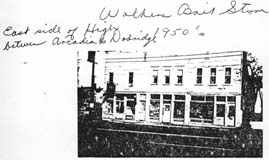
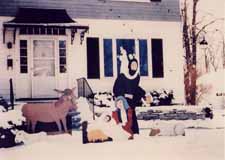 In a previous post, I mentioned that Engine House 19 won the Dispatch’s annual holiday decorating content. This house at on East North Broadway won the contest three years in a row. (Photo coourtesy of Judy Kress)
In a previous post, I mentioned that Engine House 19 won the Dispatch’s annual holiday decorating content. This house at on East North Broadway won the contest three years in a row. (Photo coourtesy of Judy Kress)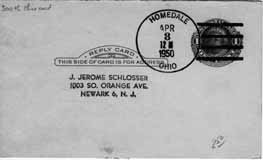 Besides the Orchard and High Street Post office, and the Evanston Post Office, there have been sundry other post offices serving the Clintonville area. This is a cancellation of Homedale’s post office, 1950, located during the 1950s in what would later become part of northern Clintonville. (Photo courtesy of Dave Foust)
Besides the Orchard and High Street Post office, and the Evanston Post Office, there have been sundry other post offices serving the Clintonville area. This is a cancellation of Homedale’s post office, 1950, located during the 1950s in what would later become part of northern Clintonville. (Photo courtesy of Dave Foust)